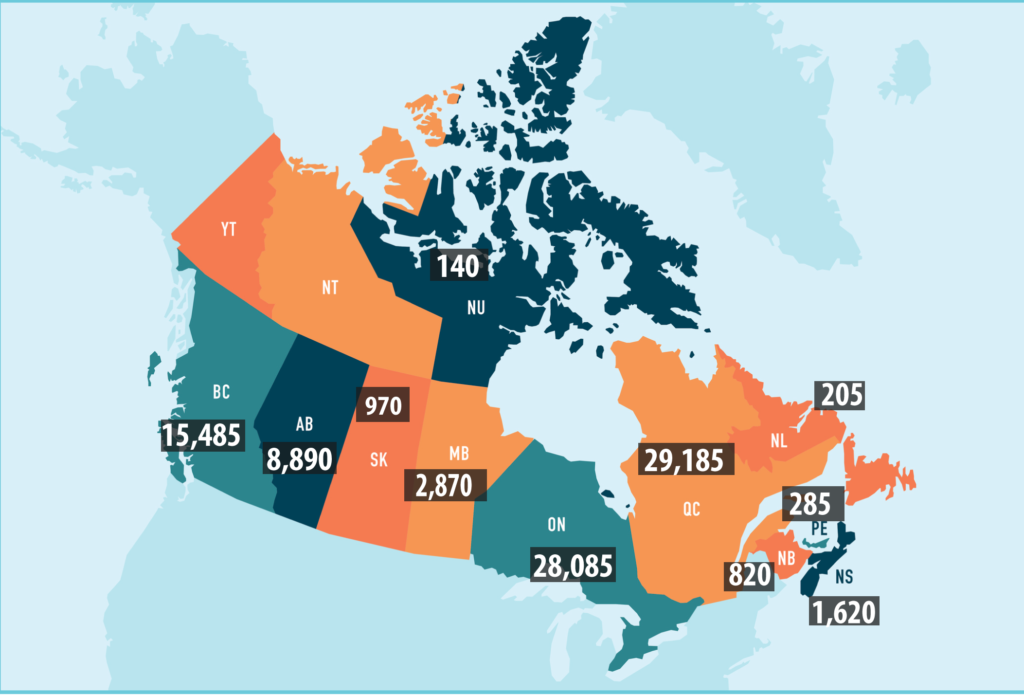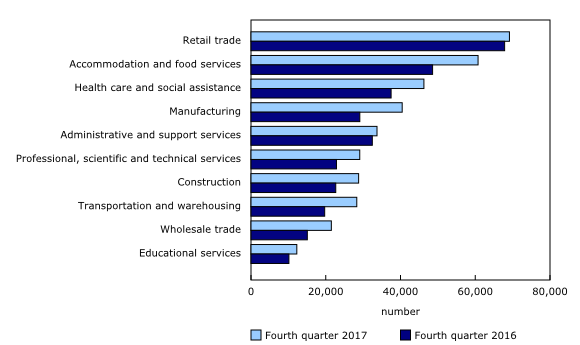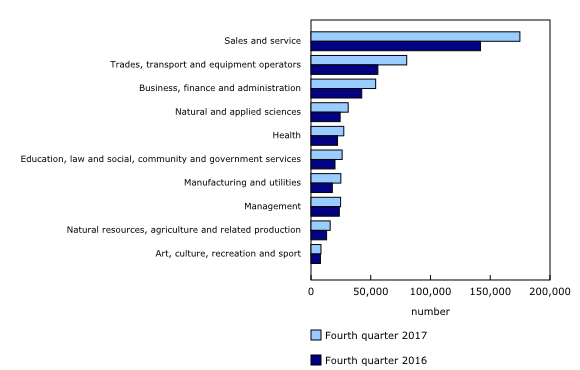Canadian job vacancies in last quarter of 2017 up nearly 25% over previous year
Job vacancies increased across Canada in the last three months of 2017 by nearly 25 per cent over the same period in 2016, new data from Statistics Canada reveal.
The numbers show year-over-year job vacancies up in nine of Canada's 13 provinces and territories in the fourth quarter of 2017, with the largest increases posted in Quebec, Ontario and British Columbia.
Across Canada, there were 470,000 job vacancies reported in the last quarter of 2017, an increase of 89,000, or 23 per cent, over the final quarter of 2016.
Statistics Canada said nearly seven out of every 10 job vacancies were for full-time work and the average offered hourly wage for the unfilled jobs was $20.10.
YEAR-OVER-YEAR JOB VACANCY INCREASES BY PROVINCE FOR Q4 2017

Statistics Canada said there were 29,185 more job vacancies in Quebec than the fourth quarter of 2016, a year-over-year increase of 46 per cent — Canada's largest. The vacancies in the majority French-speaking province were most notable in the manufacturing, accommodation and food services and finance and insurance industrial sectors.
Ontario, Canada's most populous province, had 28,085 more job vacancies in the fourth quarter of 2017 than it did in final quarter of 2016, an increase of 17.3 per cent. "This was the sixth consecutive quarter with year-over-year increases in the number of job vacancies for this province," Statistics Canada noted, adding that vacancies rose in 15 of 20 industrial sectors, including health care and social services and accommodation and food services.
On Canada's West Coast, British Columbia posted an increase of 15,485 job vacancies over the fourth quarter of 2017, a year-over-year quarterly increase of 21.2 per cent. The greatest increases in B.C. occurred in accommodation and food services and construction.
Alberta also posted a year-over-year increase of 8,890 job vacancies in the fourth quarter of 2017, a jump of 20.9 per cent over 2016, and the Atlantic province of Prince Edward Island, Canada's least populous province, saw job vacancies rise by 285, or 27 per cent, over the final quarter of 2016.
Demand outpacing labour supply
The new findings support concerns voiced in all corners of Canada, and notably Atlantic Canada, about labour shortages produced by a growing economy and an aging population that can't meet the demand for workers. This worry was echoed in a recent speech by Bank of Canada Governor Stephen Poloz, who identified immigration as an "important off-set" to this trend.
Poloz said Canada’s economy is hitting a “sweet spot” of rising demand and companies operating at near capacity, and this growth is translating into new jobs — and escalating job vacancies.
“None of this highly desirable economic growth can happen unless there are people available to fill the newly created jobs,” he said. “A healthy, well-functioning labour market is critical.”
Accordingly, Canada's immigration system is responding to this need through the introduction of a multi-year immigration levels plan that has set a target of nearly one million new admissions over the three-year period spanning 2018 to 2020, the majority of which will come through Canada's economic immigration programs.
The latest Statistics Canada data revealed that job vacancies rose in eight of Canada's 10 largest industrial sectors.
There were 29,100 job vacancies in the professional, scientific and technical services sector, an increase of 6,230 over the same period in 2016.
Job vacancies in accommodation and food services were up by 12,000, or 25 per cent, in comparison to 2016, with the increase concentrated in Quebec, British Columbia and Ontario.
JOB VACANCIES BY INDUSTRIAL SECTOR

Job vacancies increased in eight of the 10 largest industrial sectors in the fourth quarter of 2017. Source: Statistics Canada
Employers in manufacturing witnessed an increase of 11,000 job vacancies, or 39 per cent, over the same quarter the year before. Statistics Canada said job vacancies were up in most subsectors of the manufacturing industry, led by food manufacturing, fabricated metal product manufacturing, and transportation equipment manufacturing.
The number of job vacancies in health care and social assistance rose by 8,800, or 23.4 per cent, in the fourth quarter of 2017, driven by notable increases in Ontario.
There were also 8,600 more job vacancies in transportation and warehousing in the fourth quarter of 2017 compared with a year earlier, an increase of 43.5 per cent. Ontario, Quebec, and Alberta all experienced large year-over-year increases.
Occupational categories
Sales and service occupations led Statistics Canada's 10 occupational categories in terms of year-over-year job vacancies in the the fourth quarter of 2017 with 33,000 more than 2016. Quebec led Canada's provinces and territories for job vacancies in this group, followed by Ontario and British Columbia.
The natural and applied sciences occupational category had 31,115 job vacancies in the final quarter of 2017, an increase of 6,755 over the last three months of 2016.
JOB VACANCIES BY OCCUPATIONAL CATEGORY IN Q4 2016 AND 2017

Meanwhile, job vacancies in trades, transport and equipment operators rose by 24,000, or 43.1 per cent, over the last quarter of 2016. Related sectors also saw increases during the quarter, namely manufacturing, transportation and warehousing and construction. British Columbia and Alberta had the largest increases in vacancies in this occupational category.
© 2018 CICNews All Rights Reserved
- Do you need Canadian immigration assistance? Contact the Contact Cohen Immigration Law firm by completing our form
- Send us your feedback or your non-legal assistance questions by emailing us at media@canadavisa.com







